Anderson, R.F., D. Bronk, K.J. Davis, R.S. DeFries, A.S. Denning, L. Dilling, R.B. Jackson, A. Jacobson, S. Lohrenz, G. Marland, A.D. McGuire, G.A. McKinley, A.M. Michalak, C. Miller, B. Moore III, D.S. Ojima, B. O’Neill, J.T. Randerson, S.W. Running, C.L. Sabine, B. Sohngen, P.P. Tans, P.E. Thornton, S.C. Wofsy, and N. Zeng (2011), A U.S. Carbon Cycle Science Plan. A report of the University Corporation for Atmospheric Research supported by NASA, DOE, USDA, USGS, NOAA, NSF, and NIST , 69 pp., August. [pdf].
 Executive Summary: Understanding of the Earth’s carbon cycle is an urgent societal need as well as a challenging intellectual problem. The impacts of human-caused changes on the global carbon cycle will be felt for hundreds to thousands of years. Direct observations of carbon stocks and flows, process-based understanding, data synthesis, and careful modeling are needed to determine how the carbon cycle is being modified, what the consequences are of these modifications, and how best to mitigate and adapt to changes in the carbon cycle and climate. The importance of the carbon cycle is accentuated by its complex interplay with other geochemical cycles (such as nitrogen and water), its critical role in economic and other human systems, and the global scale of its interactions. Executive Summary: Understanding of the Earth’s carbon cycle is an urgent societal need as well as a challenging intellectual problem. The impacts of human-caused changes on the global carbon cycle will be felt for hundreds to thousands of years. Direct observations of carbon stocks and flows, process-based understanding, data synthesis, and careful modeling are needed to determine how the carbon cycle is being modified, what the consequences are of these modifications, and how best to mitigate and adapt to changes in the carbon cycle and climate. The importance of the carbon cycle is accentuated by its complex interplay with other geochemical cycles (such as nitrogen and water), its critical role in economic and other human systems, and the global scale of its interactions.
The need for improved understanding of the global carbon cycle and better research coordination led to the development of the first U.S. Carbon Cycle Science Plan, published more than a decade ago. That document outlined a plan for land, atmosphere, and ocean observations; manipulative experiments; and Earth-system modeling to improve our understanding of the contemporary carbon cycle and our ability to predict its future.
The development of a new Plan was initiated by the U.S. Carbon Cycle Interagency Working Group (CCIWG) and the Carbon Cycle Science Steering Group (CCSSG), and outlines a strategy for refocusing U.S. carbon cycle research based on the current state of the science. The development of this Plan was led by a committee of 25 active members of the carbon cycle research community, and the result is intended to provide U.S. funding agencies with information on community-based research priorities for carbon cycle science over the next decade. The Plan emphasizes the long-lived, carbon-based greenhouse gases, carbon dioxide (CO2) and methane (CH4), and the major pools and fluxes of the global carbon cycle. The recommended research is global in scale, and there is therefore a strong need for international cooperation and collaboration. Read more ...
Boykoff, M. (2011), COP17: Global vs Local Solutions. Think Africa Press December 1. [Read online].
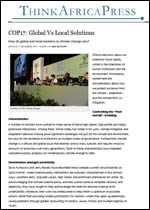 Excerpt: Critical decisions about our collective future rapidly unfold in the interstices of human institutions and the environment. Prominently nested here are considerations about how we protect ourselves from the climate - adaptation - and the climate from us - mitigation. Excerpt: Critical decisions about our collective future rapidly unfold in the interstices of human institutions and the environment. Prominently nested here are considerations about how we protect ourselves from the climate - adaptation - and the climate from us - mitigation.
A number of scholars have worked to make sense of these high stakes, high profile and highly-politicised interactions. Among them, Simon Dalby has noted in his work, climate mitigation and adaptation decision-making pose significant challenges not just for the climate and environment, but also for the resilience of institutions as multiple scales of governance. Furthermore, climate change is a diffuse and global issue that reaches across many cultures and requires massive amounts of resources over many generations. Each of these characteristics have impeded substantive policy progress on contemporary climate change to date. Read more ...
Boykoff, M. (2012), A dangerous shift in Obama’s ‘climate change’ rhetoric, Washington Post, January 27. [Read online].
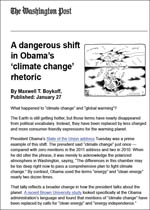 Excerpt: What happened to “climate change” and “global warming”? The Earth is still getting hotter, but those terms have nearly disappeared from political vocabulary. Instead, they have been replaced by less charged and more consumer-friendly expressions for the warming planet. Excerpt: What happened to “climate change” and “global warming”? The Earth is still getting hotter, but those terms have nearly disappeared from political vocabulary. Instead, they have been replaced by less charged and more consumer-friendly expressions for the warming planet.
President Obama’s State of the Union address Tuesday was a prime example of this shift. The president said “climate change” just once — compared with zero mentions in the 2011 address and two in 2010. When he did utter the phrase, it was merely to acknowledge the polarized atmosphere in Washington, saying, “The differences in this chamber may be too deep right now to pass a comprehensive plan to fight climate change.” By contrast, Obama used the terms “energy” and “clean energy” nearly two dozen times. Read more ...
Boykoff, M. (2012), Economies must grow for the climate change fight. The Guardian January 16. [Read online].
 Excerpt: These days, dormant climate policy in Washington D.C. is like Mitt Romney’s coiffure: seemingly no prospects for change. And, with the 2012 U.S. presidential election on the horizon, it seems there’ll be little federal action for at least another year. In fact, debates among Republican presidential candidates earlier in January saw climate change mentioned only once. It was Romney himself who invoked “the c-word” when he reminded Newt Gingrich of his mistaken support for climate action in the form of cap and trade legislation (which Gingrich has since recanted). Excerpt: These days, dormant climate policy in Washington D.C. is like Mitt Romney’s coiffure: seemingly no prospects for change. And, with the 2012 U.S. presidential election on the horizon, it seems there’ll be little federal action for at least another year. In fact, debates among Republican presidential candidates earlier in January saw climate change mentioned only once. It was Romney himself who invoked “the c-word” when he reminded Newt Gingrich of his mistaken support for climate action in the form of cap and trade legislation (which Gingrich has since recanted).
But beyond the current wedge-issue politics and culture wars on offer with climate and environment issues, the “climate problem” suffers from a more powerful and enduring force: economic stagnation. As such, immediate worries of job security and economic well-being have taken precedence in the collective conscience and public discourse. Read more ...
Morss, R.E., O.V. Wilhelmi, G.A. Meehl, and L. Dilling (2011), Improving Societal Outcomes of Extreme Weather in a Changing Climate: An Integrated Perspective. Annual Review of Environment and Resources, 36, pp. 1-25. [pdf].
 Abstract: Despite hazard mitigation efforts and scientific and technological advances, extreme weather events continue to cause substantial losses. The impacts of extreme weather result from complex interactions among physical and human systems across spatial and temporal scales. This article synthesizes current interdisciplinary knowledge about extreme weather, including temperature extremes (heat and cold waves), precipitation extremes (including floods and droughts), and storms and severe weather (including Abstract: Despite hazard mitigation efforts and scientific and technological advances, extreme weather events continue to cause substantial losses. The impacts of extreme weather result from complex interactions among physical and human systems across spatial and temporal scales. This article synthesizes current interdisciplinary knowledge about extreme weather, including temperature extremes (heat and cold waves), precipitation extremes (including floods and droughts), and storms and severe weather (including
|
tropical cyclones). We discuss hydrometeorological aspects of extreme weather; projections of changes in extremes with anthropogenic climate change; and how social vulnerability, coping, and adaptation shape the societal impacts of extreme weather. We find four critical gaps where work is needed to improve outcomes of extreme weather: (a) reducing vulnerability; (b) enhancing adaptive capacity, including decision-making flexibility; (c) improving the usability of scientific information in decision making; and (d) understanding and addressing local causes of harm through participatory, community-based efforts formulated within the larger policy context. Read more ...
Moser, S.C. and L. Dilling (2011), Communicating Climate Change: Closing the Science-Action Gap. The Oxford Handbook of Climate Change and Society 161-174, Oxford University Press, September. [pdf].
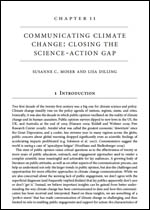 Excerpt: The first decade of the twenty-first century was a big one for climate science and policy. Climate change steadily rose on the policy agenda of nations, regions, states, and cities. Ironically, it was also the decade in which public opinion vacillated on the reality of climate change and its human causation. Public opinion surveys dipped to new lows in the U.S., the U.K., and Australia at the end of 2009 (Hanson 2009; Riddell and Webster 2009; Pew Research Center 2009b). Amidst what was called the greatest economic ‘downturn’ since the Great Depression, and a cooler, less extreme year in many regions across the globe, public concern about global warming dropped significantly even as scientific findings of accelerating impacts proliferated (e.g. Solomon et al. 2007). Commentators suggest the world is seeing a case of ‘apocalypse fatigue’ (Nordhaus and Shellenberger 2009). Read more ... Excerpt: The first decade of the twenty-first century was a big one for climate science and policy. Climate change steadily rose on the policy agenda of nations, regions, states, and cities. Ironically, it was also the decade in which public opinion vacillated on the reality of climate change and its human causation. Public opinion surveys dipped to new lows in the U.S., the U.K., and Australia at the end of 2009 (Hanson 2009; Riddell and Webster 2009; Pew Research Center 2009b). Amidst what was called the greatest economic ‘downturn’ since the Great Depression, and a cooler, less extreme year in many regions across the globe, public concern about global warming dropped significantly even as scientific findings of accelerating impacts proliferated (e.g. Solomon et al. 2007). Commentators suggest the world is seeing a case of ‘apocalypse fatigue’ (Nordhaus and Shellenberger 2009). Read more ...
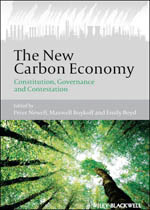 Newell, P., Boykoff, M., and Boyd, E. (2012), The New Carbon Economy: Constitution, Governance and Contestation. Wiley-Blackwell, 208 pp. [Publisher website]. Newell, P., Boykoff, M., and Boyd, E. (2012), The New Carbon Economy: Constitution, Governance and Contestation. Wiley-Blackwell, 208 pp. [Publisher website].
The New Carbon Economy provides a critical understanding of the carbon economy. It offers key insights into the constitution, governance and effects of the carbon economy, across a variety of geographical settings. Read more ...
Pielke, Jr., R. A. (2011), Lessons of the L’Aquila Lawsuit. Bridges 31, October. [Read online].
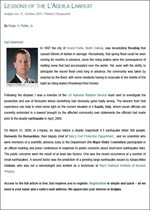 Excerpt: In 1997 the city of Grand Forks, North Dakota, saw devastating flooding that caused billions of dollars in damage. Remarkably, that spring flood could be seen coming for months in advance, since the rising waters were the consequence of melting snow that had accumulated over the winter. Yet, even with the ability to anticipate the record flood crest long in advance, the community was taken by surprise by the flood, with some residents having to evacuate in the middle of the night as rising waters threatened their homes. Excerpt: In 1997 the city of Grand Forks, North Dakota, saw devastating flooding that caused billions of dollars in damage. Remarkably, that spring flood could be seen coming for months in advance, since the rising waters were the consequence of melting snow that had accumulated over the winter. Yet, even with the ability to anticipate the record flood crest long in advance, the community was taken by surprise by the flood, with some residents having to evacuate in the middle of the night as rising waters threatened their homes.
Following the disaster, I was a member of the U.S. National Weather Service team sent to investigate the production and use of forecasts where something had obviously gone badly wrong. The lessons from that experience can help to shed some light on the current situation in L’Aquila, Italy, where seven officials are currently embroiled in a lawsuit brought by the affected community over statements the officials had made prior to the deadly earthquake in April, 2009. Read more ...
Pielke, Jr., R. A. (2011), Innovation Policy Lessons of the Vasa. Bridges 32, December. [Read online].
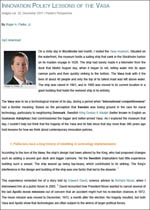 Excerpt: On a chilly day in Stockholm last month, I visited the Vasa museum. Situated on the waterfront, the museum holds a sailing ship that sank in the Stockholm harbor on its maiden voyage in 1628. The ship had barely made it a kilometer from the dock that fateful August day, when it began to roll, letting water into its open cannon ports and then quickly sinking to the bottom. The Vasa took with it the lives of about 40 people and only the top of its tallest mast was left above water. The ship was raised in 1961, and in 1990 was moved to its current location in a giant building that holds the restored ship in its entirety. Excerpt: On a chilly day in Stockholm last month, I visited the Vasa museum. Situated on the waterfront, the museum holds a sailing ship that sank in the Stockholm harbor on its maiden voyage in 1628. The ship had barely made it a kilometer from the dock that fateful August day, when it began to roll, letting water into its open cannon ports and then quickly sinking to the bottom. The Vasa took with it the lives of about 40 people and only the top of its tallest mast was left above water. The ship was raised in 1961, and in 1990 was moved to its current location in a giant building that holds the restored ship in its entirety.
The Vasa was to be a technological marvel of its day, during a period when “international competitiveness” had a familiar meaning. Based on the perception that Sweden was losing ground in the race for naval technology, particularly to neighboring Denmark, Swedish King Gustav II Adolph (better known in English as Gustavus Adolphus) had commissioned the bigger and better-armed Vasa. As I explored the museum that day, I couldn’t help but think that the tragedy of the Vasa and its fate since that day more than 380 years ago hold lessons for how we think about contemporary innovation policies. Read more ...
Pielke, Jr., R. A. (2011), Politics is about acting alike, not thinking alike. Bulletin of the Atomic Scientists, Published December 15 2011. [Read online].
Roger has his final installment in the Roundtable with Robert Socolow and Randy Olson at the Bulletin of the Atomic Scientists. The subject is how scientists should react “When Politicians Distort Science.”
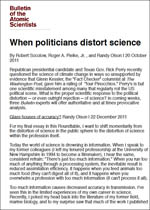 Excerpt: I’d like to return to discussing Socolow’s central claim that science is under attack and needs defending from the anti-science brigades. Excerpt: I’d like to return to discussing Socolow’s central claim that science is under attack and needs defending from the anti-science brigades.
In short, I find the evidence for such a claim sorely lacking. In these cynical times, science is among the few institutions in society that is held in high regard. (Others include the military and first responders to disasters.) The most recent survey of public attitudes about science by the National Science Foundation found that 84 percent of Americans expressed support for government funding of basic research, and Americans have more favorable attitudes toward the promise of science and technology for our future than do Europeans. Further, Americans ranked scientists higher in prestige than 23 other occupations (and at a level similar to firefighters), a view that has remained virtually unchanged in the 35 years that the NSF has conducted its surveys.
These data hardly show an institution under attack or even a loss of support for science. Yet Socolow warns ominously that “an age of darkness could lie ahead” and worries about the “alienation of large segments of the public from the scientific enterprise.” I have a hard time making sense of such general expressions of extreme concern, which are by no means unique to our exchange. Read more ... See also Roger’s blog post on the roundtable discussion.
|











